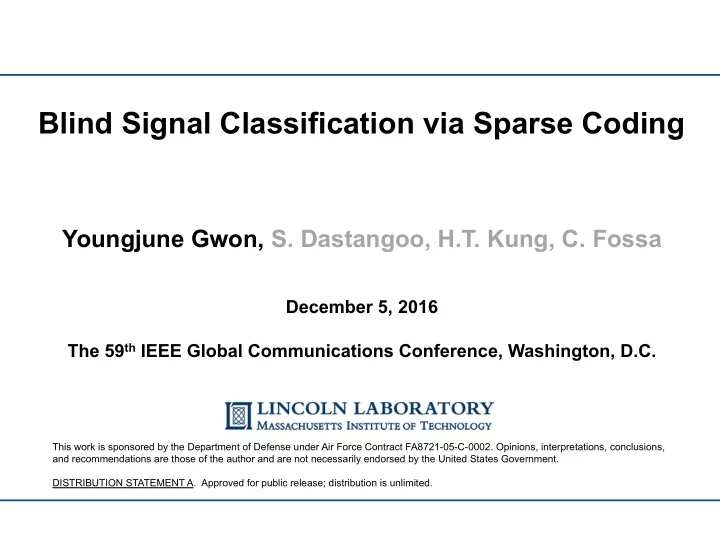

Blind Signal Classification via Sparse Coding Youngjune Gwon, S. Dastangoo, H.T. Kung, C. Fossa December 5, 2016 The 59 th IEEE Global Communications Conference, Washington, D.C. This work is sponsored by the Department of Defense under Air Force Contract FA8721-05-C-0002. Opinions, interpretations, conclusions, and recommendations are those of the author and are not necessarily endorsed by the United States Government. DISTRIBUTION STATEMENT A. Approved for public release; distribution is unlimited.
Outline • Motivation • Background • Technical Approach • Evaluation • Results • Summary GLOBECOM 2016 – 2 YG, 12/5/2016
Motivation • Competing Cognitive Radio Network (CCRN) models tactical radio networks under competition – Blue Force ( friend ) vs. Red Force ( adversary ) – Dynamic, open spectrum resource for opportunistic data access – Nodes are cognitive radios Ø Comm nodes and jammers – Strategic jamming attacks This paper is about signal classification at spectrum sensing level using semi-supervised machine learning approach GLOBECOM 2016 – 3 YG, 12/5/2016
Background: Taxonomy of Spectrum Sensing • Non-learning based spectrum sensing – Energy detection – Cyclostationary detection • Learning-based spectrum sensing – Supervised learning (requires labeled examples of all signals you want to classify) Ø Support vector machine (SVM), logistic/softmax regression, neural network – Unsupervised learning (no labeled examples required) Ø Clustering techniques (e.g., K-means, GMM): partition data mixed of unknown identities into clusters – Semi-supervised (unsupervised feature learning followed by supervised phase) Ø Sparse coding + SVM (you need some labeled examples) GLOBECOM 2016 – 4 YG, 12/5/2016
Background: Sparse Coding and Dictionary Learning • Sparse coding is an unsupervised learning method – Transforms raw data into their sparse feature representations given set of basis vectors (dictionary) • Dictionary learning – Learns basis vectors d k (dictionary atoms) required for sparse coding GLOBECOM 2016 – 5 YG, 12/5/2016
Technical Approach: Semi-Supervised Learning with Sparse Coding • Classification pipeline 1. Extract feature vectors via sparse coding: x i ⟶ y i 2. Summarize multiple feature vectors via pooling: y i ⟶ z 3. Train SVM classifiers that takes pooled sparse-coded input z • Formulation 1 Trained SVM predicts label of unknown input data GLOBECOM 2016 – 6 YG, 12/5/2016
Technical Approach (cont’d): Modification of Sparse Coder with Convolution • Classical inner-product sparse coders are not appropriate for our applications resulting in redundant dictionary atoms – Received signals are time series with unknown phases • Our enhancement: simple convolution sparse coder – For S -sparse y, take S steps of greedily choosing max convolution value and removing its contribution from x for next GLOBECOM 2016 – 7 YG, 12/5/2016
Evaluation • Simulation environment – Used MATLAB communications toolbox to generate modulated RF signals – Used LIBSVM to train SVM classifiers – Used K-SVD algorithm to learn dictionary for sparse coding • Assumptions – There are four signal classes in our experiments Ø Friendly signals: S1 (single-carrier QPSK with rectangular pulse) and S2 (OFDM with raised cosine pulse) Ø Adversary signals: S3 (QPSK with custom pulse ) and S4 (OFDM with custom pulse) • Scenarios – Case 1 (Blind clustering) – apply K-means clustering on sparse-coded signals using four classes of signals – Case 2 (One-class SVM) – train SVM classifiers using only friendly signals – Case 3 (1-vs-all SVM) – train SVM classifiers using mostly friendly signals and some adversary signals GLOBECOM 2016 – 8 YG, 12/5/2016
Results: Confusion Matrices • Confusion matrix is good for visualizing multiclass classification performance • Confusion matrices for: – Case 1 (Blind clustering) – apply K- means clustering on sparse-coded signals using four classes of signals – Case 2 (One-class SVM) – train SVM classifiers using only friendly signals – Case 3 (1-vs-all SVM) – train SVM classifiers using mostly friendly signals and some adversary signals Darkest box: 0.89 Lightest box: 0.06 GLOBECOM 2016 – 9 YG, 12/5/2016
Results: Recall & False Alarm Performance • Recall & false alarm performances for: – Blind clustering – apply K-means clustering on sparse-coded signals using four classes of signals – One-class SVM – train SVM classifiers using only friendly signals – 1-vs-all SVM – train SVM classifiers using mostly friendly signals and some adversary signals Scenarios Recall False Alarm 20 dB (0 dB) 20 dB (0 dB) Case 1 (Blind clustering) 0.703 (0.582) 0.246 (0.367) Case 2 (One-class SVM) 0.768 (0.634) 0.213 (0.307) Case 3 (1-vs-all SVM) 0.878 (0.726) 0.141 (0.262) GLOBECOM 2016 – 10 YG, 12/5/2016
Summary • Presented semi-supervised framework for RF signal classification at spectrum-sensing level based on sparse coding – Proposed sparse coding + SVM requires no prior knowledge about signals – Sparse coding dictionary can be pre-generated or learned • Developed simulation to assess performance for: – Blind clustering – apply K-means clustering on sparse-coded signals using four classes of signals – One-class SVM – train SVM classifiers using only friendly signals – 1-vs-all SVM – train SVM classifiers using mostly friendly signals and some adversary signals • Explore more practical applications with cognitive radios • Improve computational complexity – Develop efficient sparse coding and dictionary learning algorithms for mobile handsets GLOBECOM 2016 – 11 YG, 12/5/2016
Recommend
More recommend